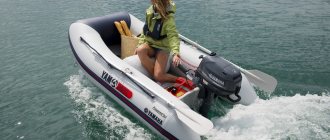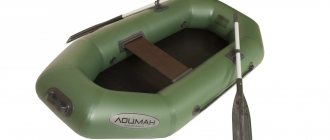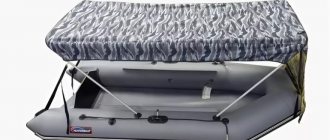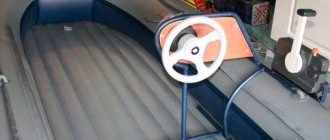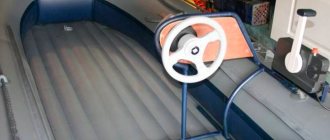- December 10, 2020
- Cars
- Elena Volkova
Almost many outdoor enthusiasts own an inflatable boat. This swimming device is the most important attribute for many hunters and fishermen.
The inflatable boat itself is a kind of swimming structure, thanks to which you can easily and simply move through the water, but only over short distances.
Currently on the market there are such swimming equipment as boats:
- Rowing.
- Motor.
- R.I.B.
What are PVC boats
Currently, such boats are the most popular boats. In order to decide how to transport a PVC boat on a trailer, you need to understand what this boat actually is.
Their advantages include the following:
- PVC boats are made exclusively from high quality materials, and therefore they are the most durable.
- Such boats themselves are very compact. Their size can vary from 3 to 4 meters.
- A PVC boat consists of several layers, that is, it is multi-layered, making it the most airtight. Due to these properties, the boat is reliably protected from salt water, and is also not affected by ultraviolet rays.
- PVC boats are the most resistant to aggressive environments.
- Such a boat does not rot at all, even over time. In addition, mold does not appear on it, and it does not wash off at all.
- Such boats weigh little. With a motor, they weigh about 60 kg, or even more.
In this regard, many hunters and fishermen prefer to use PVC boats rather than rubber ones.

What methods of transporting PVC boats exist?
Many outdoor enthusiasts wonder how PVC boats should be transported on a trailer? In order to understand this, it is recommended that you read the following information.
A rowing boat, for example, is very convenient to transport from place to place. That is, it is enough to roll it up, place it in a backpack and transport it. That is, no additional devices or means are required for its transportation. You just need to take it out of your backpack and pump it up using a pump.
Although this method is good, it is not suitable for all outdoor enthusiasts. Many fishermen and hunters prefer to transport a ready-made boat. This is convenient because it is easier to launch it into the water without performing any other manipulations.
To transport a watercraft from place to place, you can use several basic methods:
- Using a special boat motor.
- Transportation of a PVC boat on a flatbed trailer.
- Using special contact platforms.
- Using handmade designs.
- On the car itself, that is, on its roof.
Let's look at each of these methods in more detail.
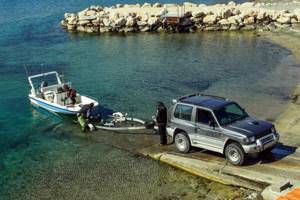
How to choose
When choosing a trailer for transporting a boat or boat, you need to take into account that this device must be equipped with a winch, which allows you to launch and pull the craft out of the river. When choosing a design, you should pay attention to devices that are equipped with brakes. Depending on the size and other characteristics of the trailer, its price changes.
Dimensions
To determine the dimensions of the trailer, you need to know the dimensions of the boat (weight, length, width and height). You need to know the model of the watercraft (keel or not). Knowing the dimensions, calculate the dimensions of the trailer:
- The length must be equal to the length of the boat plus 0.4 m to accommodate the engine. Many boat carrier designs have an adjustable bow stop that allows you to select the desired length.
- Caravan width. Since the side supports of the structure are adjustable, a boat of any size can be transported on such a vehicle. But according to the traffic rules, if the load protrudes more than 0.4 m in width from the side lights of the vehicle, it is necessary to install a “large load” sign. This must be taken into account when choosing a product.

Load capacity
To calculate the carrying capacity of a trailer for transporting a boat, you need to add up the weight of the boat and the weight of all the equipment that is installed on it. It is necessary to take into account the weight of the floor, protective devices, fastenings, etc. The resulting value must be compared with the following characteristics of the trailer: load capacity and total weight.
The trailer's carrying capacity shows how much weight the vehicle can transport. Gross weight indicates how much a loaded trailer can weigh. Knowing all these characteristics, you can select with maximum accuracy the trailer that is suitable for transporting your inflatable rubber boat. Consultants in the store will help you make the right choice and tell you about all the characteristics of the products.
Boat mounts
The following elements are used to secure the boat:
- ladders;
- fastening hooks;
- footrests;
- lodgements.
When installing on supports, you must ensure that the transom of the product does not extend beyond the fixtures. This condition must be met if the product is transported with a motor.
The engine is mounted on a trailer for transporting a rubber boat using clamping rods. You can install a sheet of plywood to create a stop. Then one edge of the product rests against the frame, and the other against the end of the engine. During transportation, you should periodically check the reliability of all fastenings. Due to temperature changes, the pressure in the cylinders changes and the fasteners may become loose.
Price
The cost of a caravan depends on its size, type, materials from which it is made, and the manufacturing company.
Model MZSA 81771B.101−05 is a trailer for an inflatable boat, it can be adjusted. Parameters: maximum length of the vehicle - 3.4 m, load capacity - 570 kg, single-axle. The cost is 42,500 rubles.
Universal trailer MZSA 81771C.101−05 - parameters: maximum boat length - 3.9 m, load capacity - 560 kg, single-axle. The cost is 43,100 rubles.
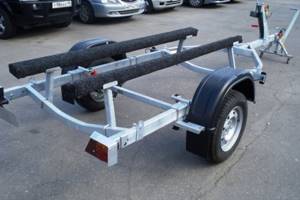
LAV-81 015V - parameters: the longest length of the boat that can be transported when transporting a boat is 3.5 m, load capacity is 520 kg, single-axle. The model costs 41,000 rubles.
“Vodnik” 8213 B5 - indicators: maximum length of the boat - 5 m, load capacity - 540 kg, single-axle, costs 47,000 rubles.
MZSA 81771G.011−05 - indicators: maximum length of the boat - 4.75 m, load capacity - 475 kg, single-axle, costs 62,200 rubles.
Using a trailer with sides
Today this method of transportation is the most common. However, this method of transportation is not the most optimal option. Its disadvantages include the following:
- This trailer has folding sides. Their main problem is the presence of sharp corners.
- The trailer has bolt heads sticking out. This is also not good, since protruding bolt heads can damage the bottom of the boat or the cylinders.
Therefore, in order to avoid unpleasant consequences, you need to try to improve the trailer for transporting a PVC boat with your own hands. You can even purchase a special bedding for these purposes. It can be used to cover sharp corners. If you make such small modifications, you can safely transport a PVC boat in such a trailer.
To ensure that the boat holds tightly during transportation and does not fray, it is recommended to prepare the slings in advance. It is thanks to them that you can secure your watercraft very well and thereby make the transportation process more reliable.
As for the boat, it is best to transport it either with the keel up or, conversely, down. As for the motor, it is better to transport it separately.
But the trailer itself should in no case be smaller than the boat (more is possible).
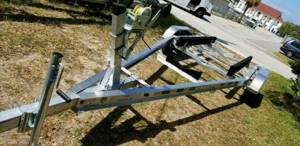
Trailer registration
A device for transporting a boat requires registration with the traffic police. Therefore, after purchasing a trailer, it must be registered within 10 days from the date of purchase.
To register you will need:
- Collect a package of documents, which consists of:
- a document confirming your identity;
- vehicle passport, which is issued upon purchase;
- purchase and sale agreement.
- Contact any traffic police department , regardless of your place of registration or residence, and fill out an application for trailer registration according to the sample.
- Pay the state fee , the amount of which can range from 350-1500 rubles depending on the type of registration actions.
- Provide the purchased device for inspection to a traffic police inspector , who will check the VIN numbers and put the appropriate mark on the completion of the procedure.
- Submit documents for registration.
Upon completion of registration, you will receive a certificate of registration, as well as a state registration mark. A registration note will be made in the vehicle's passport.
Once every two years for trailers that are less than 5 years old, and once a year - if longer, the trailer must be inspected. The date of each inspection is indicated in the coupon for the device.
Advice! To successfully pass the inspection, owners of covered trailers will need to waterproof the roof. This procedure is mandatory for everyone living in areas with an unfavorable climate.
For owners of categories “B”, “C” and “D”, the use of light trailers with a weight not exceeding the weight of the loaded vehicle is allowed, and the total sum of the vehicle and trailer must be less than 3500 kg. For heavier installations you will need to open category “E”.
Using a Boat Trailer
You can also transport a PVC boat on a regular trailer. The winch and light alarm are the most important components of this trailer. It is best to transport an inflatable boat on this vehicle with the keel down. The motor should be transported separately from the boat, either in the car itself or directly in the craft itself. In situations where the motor cannot be removed, you must try to secure it as tightly as possible with belts so that it does not fall off during transportation. Therefore, in this case, it is best for it to be in a lowered position. The boat also needs to be securely secured to the trailer.
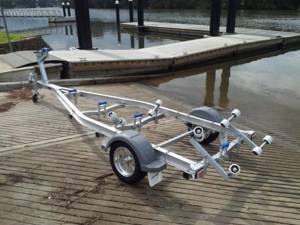
Why a trailer is a good thing
Using a trailer to transport a boat has the following advantages:
- The device is equipped with fastenings with rollers and cradle, with which you can securely fasten the device.
- Trailers for PVC boats can transport cargo even on uneven roads thanks to springs.
- The ground clearance of this device is similar to that of a car.
- It can be used to transport the product in its finished form; there is no need to inflate it when fishing.
- The boat can be transported on a trailer even with a motor.
When driving a car with a trailer, you can drive at a speed of 80 km/h. If driving on bad roads, the device must be well secured. The motor must be mounted in an inclined position to avoid damaging the propeller.
A large selection of designs makes it possible to purchase a product that suits all parameters. If you wish, you can make a homemade trailer on your own, taking into account the individual characteristics of transporting the boat.
Moving a boat on the roof of a car
It is very important, before transporting a PVC boat, to familiarize yourself with all the methods of transporting PVC boats on a trailer.
Moving a boat on the roof of a car is used when there are no other options for transporting the boat. In order to properly transport a boat in this way and not violate the rules of transportation, you must have a special trunk, in addition to this, also crossbars.
With this method of transportation, it is best to place the watercraft upside down. The best way to secure it is with straps.
The main disadvantage of this method of transportation is that if the boat is not secured correctly, then either the boat itself or the car may be damaged. Each driver chooses which transportation method to choose according to his or her capabilities.
Types of rubber boat trailers
There are two types of trailers.
1. Cargo trailer. You can install a rubber boat on it and transport it to the required location. An assistant is needed here. It is unlikely that you will be able to pull the boat alone. There are also problems with getting off the trailer. First you need to remove the boat from the trailer, and only then drag it into the pond. Additional help will be needed here too.
This type of trailer is divided into two groups:
• For transport with a flat bottom. It will not be possible to transport it with a keel on such a trailer; • For transporting all types of boats. There is a recess under the keel to make it convenient to transport. Sometimes there are collapsible structures.
2. Special trailers that are equipped with supports. They look like two pipes installed longitudinally. Sufficiently powerful trailers capable of transporting catamarans, boats, etc. The main advantage is ease of use and low weight. From this type of trailer, boats can be lowered independently and directly into the pond. Even an elderly person or a person without special training can cope. Such designs are most often foldable, which is convenient for storage.
There are two types:
• Single axle trailer. Cheap looking, but most inconvenient to use. Problems will arise during transportation even due to small turns or bumps. The disadvantages also include lack of versatility. The size is selected to transport the boat; • Double axle trailer. More expensive look, but more practical. It is better balanced, which makes the trailer more maneuverable and passable on difficult sections of the road. With it you can develop a good speed, and not drive 20 km/h. You can transport not only rubber boats, but also motor boats. They have a high load capacity.
Most often, professionals choose biaxial trailers. Due to the fact that they are collapsible and easy to transport. When purchasing a trailer, you need to ensure that it is equipped with a winch. It allows you to lower and pull the boat out of the water.
Transport using transom wheels
Transom wheels are additional devices that, like trailers, are directly involved in the transportation of a watercraft. In order to use this method, you need to attach the wheels to the transom (this is best done from the outside). With the help of such devices, moving the watercraft from place to place is easy and simple.
Transom wheels can be divided into several main types:
- Wheels with stiletto heels.
- Tilt and turn wheels.
And if we classify them by purpose, then they are:
- Removable.
- Twin.
These wheels have several advantages. These include the following:
- Such a boat has new possibilities.
- The wheels themselves are very compact.
- During operation, they are an additional convenient device.
- When transporting a watercraft, you can significantly save time.
- Thanks to the wheels, the mobility of the boat increases.
- These wheels are very easy to install.
Despite the advantages, they have one huge drawback - high cost. Therefore, many outdoor enthusiasts prefer to make such wheels themselves.

Trolley and trailer
Both the cart and the trailer perform exactly the same functions as the transom wheels. Thanks to them, you can easily and simply transport a PVC boat from one place to another.
The advantages of using a trolley include the following:
- The cart itself is compact and very versatile.
- It doesn't require much space to place it.
- Thanks to the trolley, you can transport absolutely any vehicle.
Car requirements, tips
There are several different ways to transport PVC boats. And each of them has its own advantages and disadvantages. Each owner of PVC boats chooses the appropriate transportation method for himself.
Many experienced experts advise outdoor enthusiasts to transport their watercraft in any convenient way, with the exception of two - in the trunk and on the roof of the car.
A rack is not a suitable way to transport PVC boats. It is suitable only for folding versions of inflatable boats, which can be easily and quickly pumped up and deflated.
Transporting a watercraft directly on the roof of a vehicle is also not a suitable transportation option. In this case, the length of the boat should not be more than 2.5 meters. To prevent the load from moving or falling, it is necessary to observe a certain speed limit - 50 km/h. In addition, the swimming device must be tightly fixed in several places, namely tied. It is best to do this along the stern and bow.


